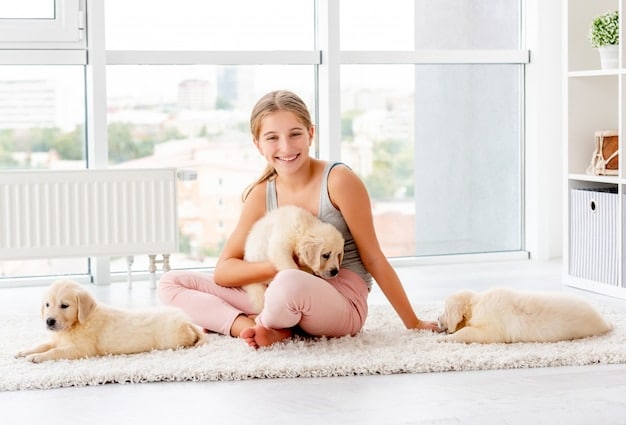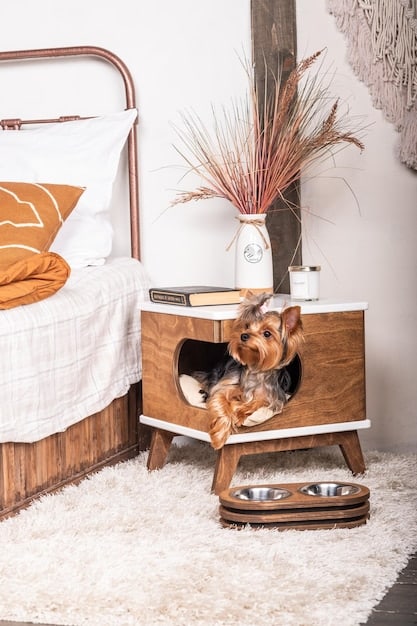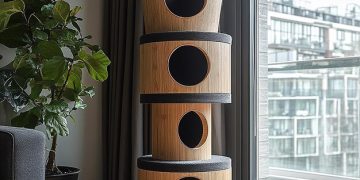Dog Crate Reviews: Find the Perfect Size & Style in 2025

Dog crate reviews are essential for pet owners seeking the perfect balance of comfort, security, and style, and this article will guide you through the key features and considerations for selecting the ideal crate for your pup in 2025, ensuring they have a safe and cozy den.
Finding the right dog crate can feel overwhelming, but it’s a vital step in providing your furry friend with a safe and comfortable space. In this comprehensive guide, we’ll delve into dog crate reviews, size considerations, and style options to help you make the best choice for your pup in 2025.
Understanding the Importance of Dog Crate Reviews
Dog crate reviews offer invaluable insights from fellow pet owners, shedding light on the pros and cons of various models. By analyzing these reviews, you can avoid common pitfalls and choose a crate that aligns with your dog’s specific needs and your lifestyle.
Benefits of Reading Dog Crate Reviews
- Real-world experiences: Reviews provide firsthand accounts of crate durability, ease of use, and dog comfort.
- Identifying potential issues: You can spot recurring problems like flimsy latches or inadequate ventilation.
- Comparing different brands and models: Reviews help you differentiate between various options and make an informed decision.
Where to Find Reliable Dog Crate Reviews
- Online retailers: Sites like Amazon, Chewy, and Petco often feature customer reviews.
- Pet-specific forums and communities: These platforms offer in-depth discussions and personal recommendations.
- Veterinarian and trainer recommendations: Professionals can provide expert advice based on their experience.
Ultimately, taking the time to thoroughly research dog crate reviews is a crucial step in ensuring you select a safe, comfortable, and suitable crate for your beloved canine companion.
Determining the Correct Dog Crate Size
Selecting the right size dog crate is essential for your dog’s comfort and safety. A crate that’s too small can feel cramped and stressful, while one that’s too large might not provide the secure den-like feeling that dogs often seek.
Measuring Your Dog for a Crate
To determine the ideal crate size, measure your dog while they are standing. Measure from the tip of their nose to the base of their tail and from the top of their head to the ground. Add 2-4 inches to both measurements to allow for comfortable movement.
General Size Guidelines
- Extra Small (XS): Up to 12 inches long – Suitable for toy breeds like Chihuahuas.
- Small (S): 13-18 inches long – Ideal for small breeds like Dachshunds.
- Medium (M): 19-24 inches long – Fits medium-sized breeds like Beagles.
- Large (L): 25-30 inches long – Appropriate for larger breeds like Border Collies.
- Extra Large (XL): 31-36 inches long – Designed for giant breeds like Great Danes.
Adjustable Dividers: A Practical Solution
If you’re purchasing a crate for a puppy, consider one with adjustable dividers. This allows you to size the crate appropriately as your puppy grows, preventing them from using the extra space as a bathroom area.

Remember, the goal is to provide a space where your dog can stand up, turn around, and lie down comfortably. By carefully measuring your dog and considering their breed, you can select a crate size that promotes both physical comfort and emotional security.
Exploring Different Dog Crate Styles and Materials
Dog crates come in a variety of styles and materials, each offering unique benefits and drawbacks. The best choice for your dog will depend on their individual needs, temperament, and your lifestyle.
Wire Dog Crates: Affordability and Visibility
Wire crates are a popular choice due to their affordability and excellent ventilation. They also provide good visibility for your dog, allowing them to see their surroundings.
Plastic Dog Crates: Durability and Portability
Plastic crates are known for their durability and ease of cleaning. They are also often preferred for travel, as they offer a more enclosed and secure environment.
Soft-Sided Dog Crates: Comfort and Portability
- Lightweight and easy to carry: Perfect for travel and temporary use.
- Comfortable and cozy: Often feature soft, plush interiors.
- Not suitable for heavy chewers: Can be easily damaged by destructive dogs.
Furniture Dog Crates: Style and Functionality
Furniture crates are designed to blend seamlessly with your home décor. They often double as end tables or other functional furniture pieces.

Each style offers unique advantages, so consider your dog’s needs, your lifestyle, and your aesthetic preferences when making your decision. Balancing functionality with style ensures you select a crate that benefits both you and your furry companion.
Essential Features to Look for in Dog Crate Reviews
When reading dog crate reviews, pay close attention to specific features that contribute to the crate’s overall quality and functionality. These features can significantly impact your dog’s comfort, safety, and your convenience.
Durability and Construction Quality
A well-constructed crate should be made from durable materials that can withstand daily use. Look for sturdy latches, reinforced corners, and a solid frame.
Security Measures
- Secure latches: Prevent accidental escapes.
- Rounded edges: Minimize the risk of injury.
- Well-ventilated design: Ensures proper airflow.
Ease of Cleaning
Accidents happen! Choose a crate with a removable, easy-to-clean tray or pan. This will make cleanup a breeze.
Portability and Storage
Consider whether you’ll need to transport the crate frequently. Folding crates are ideal for travel and storage, as they can be easily collapsed when not in use.
By prioritizing these essential features, you can narrow down your options and select a crate that provides a safe, comfortable, and convenient space for your dog. Always read dog crate reviews carefully to gauge the real-world performance of these features.
Tips for Introducing Your Dog to Their New Crate
Introducing your dog to their new crate requires patience, positivity, and consistency. A gradual and positive introduction can help your dog associate the crate with safety and comfort, rather than fear or anxiety.
Make the Crate a Positive Space
- Place treats and toys inside: Encourage your dog to explore the crate on their own.
- Feed your dog meals inside the crate: Create positive associations with food.
- Never use the crate as punishment: This can create negative associations and anxiety.
Gradual Introduction
Start by leaving the crate door open and allowing your dog to enter and exit freely. Gradually increase the amount of time your dog spends inside the crate, closing the door for short periods at first.
Create a Comfortable Environment
Add a soft bed, blanket, and familiar toys to make the crate feel like a cozy den. This will encourage your dog to relax and feel secure.
Consistency is Key
Be consistent with your training and crate schedule. This will help your dog learn to trust and accept the crate as a safe and comfortable space.
By following these tips and remaining patient, you can help your dog adjust to their new crate and create a positive association that will benefit both of you.
Maintaining and Cleaning Your Dog Crate
Regular maintenance and cleaning are essential for keeping your dog’s crate hygienic and comfortable. A clean crate not only promotes your dog’s health but also prevents unpleasant odors and extends the life of the crate.
Daily Cleaning
Remove any soiled bedding or toys daily. Wipe down the crate’s interior surfaces with a damp cloth to remove dirt and debris.
Weekly Deep Cleaning
- Remove the crate tray or pan: Wash it with warm, soapy water.
- Clean the crate’s interior: Use a pet-safe disinfectant to eliminate bacteria and odors.
- Wash bedding and blankets: Launder them regularly to remove dirt and allergens.
Preventing Odors
Use odor-absorbing products specifically designed for pet crates. These can help neutralize unpleasant smells and keep the crate fresh.
Regular Inspections
Check the crate regularly for any signs of damage, such as broken latches or sharp edges. Repair or replace damaged parts to ensure your dog’s safety.
Consistent cleaning and maintenance will not only keep your dog’s crate in top condition but also provide a healthier and more enjoyable environment for your furry friend. A well-maintained crate is a happy crate!
| Key Point | Brief Description |
|---|---|
| 📏 Correct Size | Ensure the crate allows your dog to stand, turn, and lie down comfortably. |
| 🛡️ Safety First | Look for secure latches and non-toxic materials for your dog’s well-being. |
| 🧼 Easy Cleaning | Opt for a crate with a removable tray for easy and quick cleanup. |
| ✨ Positive Intro | Introduce the crate gradually with treats and toys to create a positive space. |
Frequently Asked Questions
▼
Measure your dog from nose to tail and from head to floor. Add 2-4 inches to each measurement to ensure they can stand, turn, and lie down comfortably inside the crate.
▼
Make the crate inviting with treats and toys. Feed your dog meals inside to create positive associations. Gradually increase the time they spend inside, never using it as punishment.
▼
Crates provide a safe and secure den for your dog, aid in housetraining, prevent destructive behavior, and offer a comfortable space during travel or stressful situations.
▼
Wire crates offer better ventilation and visibility, while plastic crates are more durable and enclosed, making them suitable for nervous dogs or travel. Choose based on your dog’s needs.
▼
Clean the crate daily by removing any soiled items and wiping down surfaces. Perform a deep cleaning weekly, washing the tray, interior, and bedding to maintain hygiene.
Conclusion
Choosing the right dog crate involves careful consideration of size, style, essential features, and a positive introduction process. By utilizing dog crate reviews and following our guidelines, you can provide your furry friend with a safe, comfortable, and secure haven that promotes their well-being and happiness.





